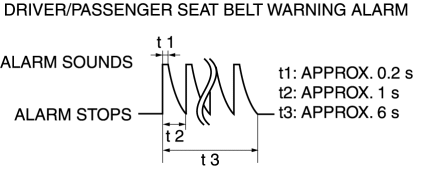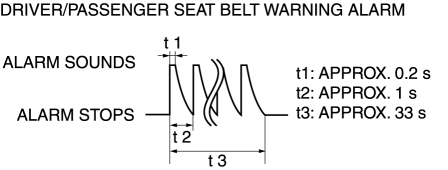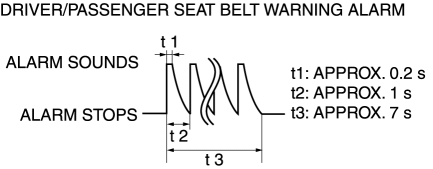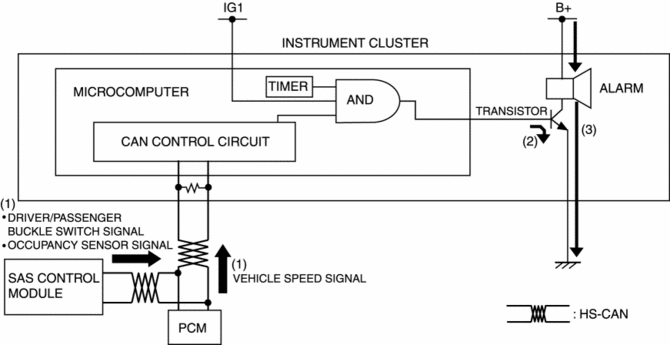Mazda CX-5 Service & Repair Manual: Seat Belt Warning Alarm
Purpose
-
The seat belt warning alarm warns occupants that a seat belt is not fastened.
Function
-
The instrument cluster sounds the seat belt warning alarm based on the following CAN signals:
-
Vehicle speed signal sent from PCM
-
Driver/passenger buckle switch signal, occupancy sensor signal sent from SAS control module
Driver/passenger seat belt warning alarm sound function
-
The driver/passenger seat belt warning alarm has a warning for when the vehicle is stopped, while the vehicle is being driven, and subsequent warnings while the vehicle is being driven.
-
When all of the following conditions have been met, the alarm sounds.
-
Ignition switch ON (engine off or on)
-
Driver/passenger buckle switch on signal (seat belt unfastened) is detected
-
Occupancy sensor on signal (occupant in passenger seat) is detected (passenger seat belt warning alarm only)
-
The driver/passenger seat belt warning alarm sound pattern is as shown in the figure.

-
When all of the following conditions are met, the alarm sounds.
-
Vehicle speed is approx. 20 km/h {12 mph} or more
-
Driver/passenger buckle switch on signal (seat belt unfastened) is detected
-
Occupancy sensor on signal (occupant in passenger seat) is detected (passenger seat belt warning alarm only)
-
The driver/passenger seat belt warning alarm sound pattern is as shown in the figure.

-
When all of the following conditions are met, the alarm sounds.
-
Vehicle speed is approx. 20 km/h {12 mph} or more
-
Occupancy sensor on signal (occupant in passenger seat) is detected (passenger seat belt warning alarm only)
-
After initial warning operates, buckle switch off signal (seat belt fastened) to on signal (seat belt unfastened) is detected
-
The driver/passenger seat belt warning alarm sound pattern is as shown in the figure.

-
Warning while vehicle is stopped
-
Warning while vehicle is being driven
-
Subsequent warning
Construction
-
The seat belt warning alarm sounds using the buzzer built into the instrument cluster.
Operation
1. The instrument cluster receives (1) the vehicle speed signal from the PCM, the driver/passenger buckle switch signal and occupancy sensor signal from the SAS control module when the ignition is switched ON (engine off or on).
2. The instrument cluster microcomputer turns the transistor on (2) based on each signal.
3. When the transistor turns on, a ground circuit with the alarm is established and the alarm sounds (3).

Fail-safe
-
Function not equipped.
 Power Steering Malfunction Indicator Light
Power Steering Malfunction Indicator Light
Purpose
The power steering malfunction indicator light warns the driver that there
is a malfunction with the electric power steering (EPS) system.
Function
If there is a malfunc ...
 Seat Belt Warning Light
Seat Belt Warning Light
Purpose
The seat belt warning light warns the driver that a seat belt is not fastened.
Function
The instrument cluster flashes/illuminates the seat belt warning light based
on t ...
Other materials:
Knock Sensor (Ks)
Purpose/Function
Detects abnormal combustion in the cylinder as basic information for mainly
determining the ignition timing.
Detects abnormal combustion in the combustion chamber and inputs it to the
PCM as a knocking signal.
Construction
Installed on the cylinder ...
Front Door Latch Switch
Purpose, Function
Switches on/off in conjunction with the latch lever rotation, and detects
the front door open/closed condition by the voltage which is changed by the
rear body control module (RBCM).
Construction
The switch is turned on/off by the rotation of the latch lev ...
Headliner
Purpose/Function
The headliner is equipped with a shock absorbing pad for driver's head protection
during a collision.
Construction
The front and rear side of the headliner is equipped with a shock absorbing
pad with a plastic rib-pad structure.
...
